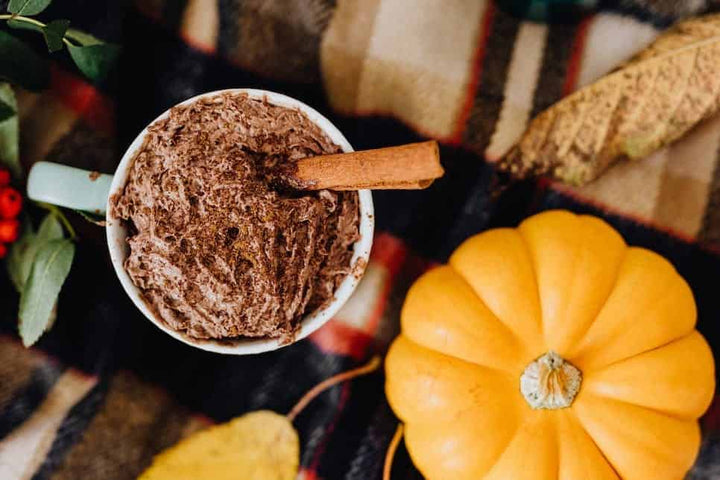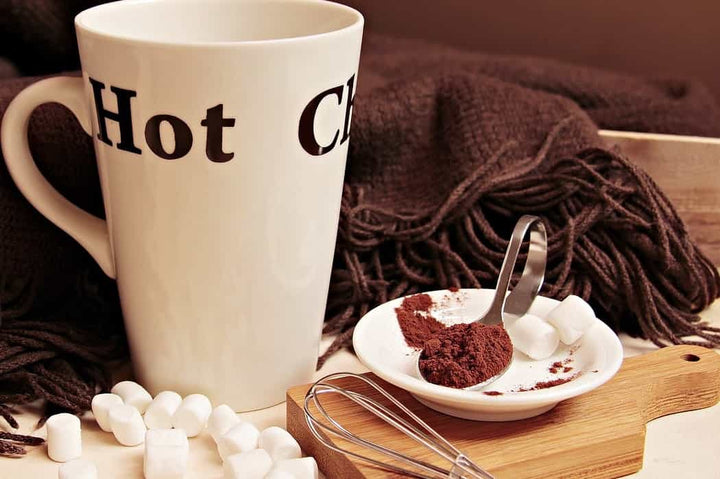This post delves into the lifespan of hot chocolate, exploring factors that influence its shelf life and providing insights to ensure that every sip is as delightful as it should be, free from any unwarranted surprises.
Keep reading to unravel the mysteries behind hot chocolate's expiration and learn how to maximise its shelf life, ensuring its sumptuous flavour remains intact.
Does Hot Chocolate Go Out of Date?
Hot chocolate can go out of date. The ingredients within hot chocolate powder, such as cocoa, sugar, and often milk solids, have a finite shelf life, after which they may degrade in quality.
The “best before” date on the packaging provides a guideline as to how long the product will maintain its optimal flavour and texture, but it’s generally safe to consume the product after this date, although the taste may be somewhat diminished.
However, a “use by” date, more common on liquid hot chocolate products, is more strict and denotes the limit of the product’s safety for consumption.
Environmental conditions play a significant role in the longevity of hot chocolate.
Hot chocolate can absorb moisture if stored improperly, leading to clumping and potential spoilage.
Keeping it in a cool, dry place, sealed away from air and light, will help preserve its quality for longer.
The presence of any unusual odours, flavours, or appearances, such as mould, indicates that the hot chocolate is no longer safe to consume and should be discarded.
Related Post: Xocolatl - A Complete Guide.
Can You Get Sick From Expired Hot Chocolate Powder?
Consuming expired hot chocolate powder can potentially make you ill, although it's relatively rare if the product has been stored correctly.
Hot chocolate powder usually has a long shelf life and often remains safe to consume after its best-before date, but its flavour and texture might be compromised.
The risk comes when the powder has been exposed to moisture or contaminants, leading to the growth of mould or bacteria, which are not always visible to the naked eye.
Consuming such spoiled or contaminated hot chocolate can cause sickness, with symptoms like stomach ache, vomiting, or diarrhoea.
Storing hot chocolate powder properly in a cool, dry place and in a sealed container is pivotal to avoiding moisture and contaminants.
If the powder appears clumpy, has an off smell, or shows any signs of mould, it’s best to err on the side of caution and dispose of the product.
Can You Drink Out Of Date Hot Chocolate Powder?
Like other dry, powdered food items, hot chocolate powder generally comes with a 'best before' date rather than a 'use by' date.
The 'best before' date is primarily an indicator of quality, suggesting when the product will likely lose its flavour and efficacy.
Consuming products past their 'best before' date does not typically pose a health risk, assuming the product has been stored correctly and there are no signs of spoilage.
However, inspecting the powder for any signs of mould, unpleasant odours, or alterations in appearance or texture is crucial.
If the powder seems clumped together, it could be a sign of moisture exposure, which can lead to spoilage.
In essence, if your out-of-date hot chocolate powder has been stored appropriately and shows no spoilage, it can usually be consumed without immediate harm, but with the understanding that the taste and quality might not be at their peak.
How To Tell If Hot Chocolate Powder Is Expired?
When trying to determine if hot chocolate powder is expired, especially if it’s past its ‘best before’ date, several signs can help you make a judgement.
1. Check the 'Best Before' Date:
While the 'best before' date primarily signifies the period during which the product maintains optimal quality, it's the first place to check.
After this date, the hot chocolate may not taste as intended, but it doesn’t necessarily mean it’s unsafe to consume.
2. Examine the Appearance:
Inspect the powder thoroughly. If it exhibits any changes in colour or visible signs of mould or any other foreign substances, it’s best not to consume it.
3. Assess the Texture:
The texture of the powder should be loose and free-flowing. If the powder has hardened or clumped together, it might indicate that moisture has entered the container, which could lead to spoilage.
4. Smell the Powder:
A sour or off-putting odour is a clear indication that the hot chocolate powder is spoiled and should not be consumed.
5. Look for Signs of Pests:
Ensure no signs of infestation, such as insect fragments or droppings. If there are, discard the powder immediately.
6. Check the Packaging:
Any damage to the packaging, like punctures or tears, can expose the contents to air and contaminants, potentially leading to spoilage.
7. Storage Conditions:
If the hot chocolate powder has been stored in a cool, dry place and kept well-sealed, it is likely to last longer past its 'best before' date without spoiling.
If in doubt, it’s always safest to err on the side of caution and avoid consuming the product.
When Should You Throw Away Hot Chocolate Powder?
Hot chocolate powder should generally be safe to consume for some time past its 'best before' date as long as it’s been stored correctly.
However, there are specific instances when it’s best to err on the side of caution and dispose of it:
1. Visible Spoilage or Contamination:
You should discard the powder immediately if there are clear signs of mould, foreign substances, or pest infestations.
2. Unpleasant Odour or Taste:
If the hot chocolate powder emits an off or sour smell or tastes unusual or unpleasant, it’s advisable to throw it away.
3. Texture Changes:
Should the powder have become clumpy or hard, suggesting that moisture has penetrated the packaging, it is safest to discard the product.
4. Packaging Damage:
If the packaging is damaged, with visible tears or holes, potentially exposing the powder to air and contaminants, then it’s best to dispose of the product.
5. Extended Storage Past Best Before Date:
While 'best before' dates are about quality rather than safety, if the hot chocolate powder is significantly past this date, it might be prudent to replace it.
6. Allergic Reactions or Illness:
If consuming the hot chocolate results in any adverse reactions or illnesses, cease consuming and dispose of the remaining powder.
Remember, 'best before' dates are indicators of quality, and products can often be safely consumed after this date, but the instances above are clear signs that your hot chocolate powder needs to be discarded.
When unsure, prioritise health and safety and opt not to consume the product.
Related Post: Chocolate Allergy.
How Long Can You Store Hot Chocolate Before It Goes Off?
Like many food items, hot chocolate comes with a 'best before' date rather than a 'use by' date, reflecting its quality over time rather than its safety.
Typically, hot chocolate powder can maintain its optimal quality for about two years when stored in a cool, dry place and kept well-sealed to prevent exposure to moisture and air.
Factors Affecting Storage Life:
-
Storage Conditions: Hot chocolate powder stored in a cool, dark, and dry place will last longer compared to those stored in warm, humid environments.
-
Packaging: The integrity of the packaging affects the product's shelf life. Any damages or openings in the packaging can lead to spoilage.
-
Ingredients: Hot chocolate varieties with added dairy or other perishable ingredients may have a shorter shelf life compared to those made predominantly with cocoa and sugar.
While hot chocolate may lose some of its flavour or quality after the 'best before' date has elapsed, it does not necessarily mean it’s unsafe to consume.
However, any visible signs of spoilage, such as mould, unusual odours, or a change in appearance or texture, indicate that hot chocolate should no longer be consumed.
Can You Freeze Leftover Hot Chocolate?
Freezing leftover hot chocolate can be a convenient solution if you've made too much, and it doesn't take too much effort.
Here’s how you can freeze leftover hot chocolate:
-
Allow to Cool: Ensure the hot chocolate is completely cool before freezing to maintain quality and avoid lowering the overall temperature of the freezer.
-
Use Appropriate Containers: Pour the cool hot chocolate into freeze-safe containers or bags. Leave some space at the top, as the liquid will expand when it freezes.
-
Label the Containers: Label the container or bag with the date so you know when it was frozen.
-
Freeze Promptly: Freeze the leftover hot chocolate as soon as possible to maintain its quality.
To Use Frozen Hot Chocolate:
-
Thawing: When ready to use the frozen hot chocolate, allow it to thaw in the fridge or by using the defrost setting on a microwave.
-
Reheating: Once thawed, reheat it on the hob or microwave, stirring occasionally to ensure it heats evenly.
-
Adjust Consistency and Flavour: Freezing and thawing may slightly alter the consistency and flavour. Feel free to adjust by adding a bit of milk, cream, or a sweetener to get it back to your preferred taste and texture.
Remember, freezing can alter the texture and flavour slightly, so it's best used when you plan to consume the hot chocolate relatively soon after freezing, and it's ideal for recipes where the texture change won’t matter as much, such as in baking or making hot chocolate popsicles.
Where Can You Buy British-Made Cooking Chocolate?
For those in pursuit of sumptuous UK-made cooking chocolate, look no further than Whitakers Chocolates, a family-run company steeped in over 135 years of chocolate crafting expertise.
Rooted deeply in British tradition and heritage, we are renowned for our meticulous attention to quality and flavour, ensuring each piece of chocolate is a testament to our passion and craftsmanship.
Our dedication to the culinary arts has led to the development of our specially designed ‘Easymelt’ Dark Chocolate Mini Shards, an exemplary choice for both cooking and baking.
Created with culinary aficionados in mind, ‘Easymelt’ is composed of 55% dark couverture chocolate, promising the finest quality and all-natural composition.
Some Notes From an Expert Chocolatier
As an expert chocolatier from Whitakers, educating on the significance of ensuring that hot chocolate is safe to consume is crucial.
It is essential to be vigilant about the expiration date on the packaging, as consuming the product post this date can compromise flavour and potentially lead to health problems.
Also, any signs of clumps, off smells, mould, or discolouration in the powder should prompt immediate disposal, as red flags indicate it is unfit for consumption.
Appropriate storage is another factor, with ideal conditions being cool and dry places, avoiding direct sunlight and moisture to maintain the quality and safety of the hot chocolate powder.
Inspection of the packaging is also crucial. Any signs of damage, holes, or tampering can imply contamination, making the product unsafe.
Final Notes On If Hot Chocolate Goes Out of Date
Hot chocolate does indeed have an expiry date, and it’s imperative to regard it to ensure safety and optimum flavour.
The delicate balance between cocoa's luxurious richness and sugar's sweet subtlety can be disrupted if consumed past its prime, compromising taste and potential health risks.
It’s pivotal to store hot chocolate properly in cool, dry places and to regularly inspect the powder for any signs of spoilage such as clumping, mould, or off smells.
The integrity of the packaging is also crucial, as any compromise can lead to contamination.
Consumers are advised to be vigilant and prioritise health by discarding hot chocolate that appears, smells, or tastes off.











